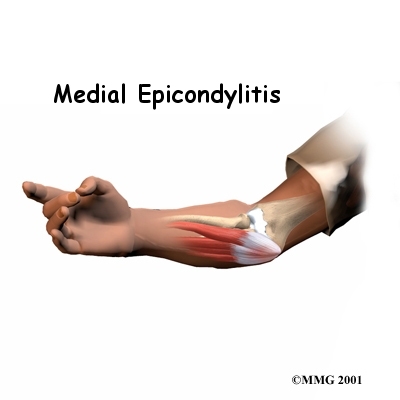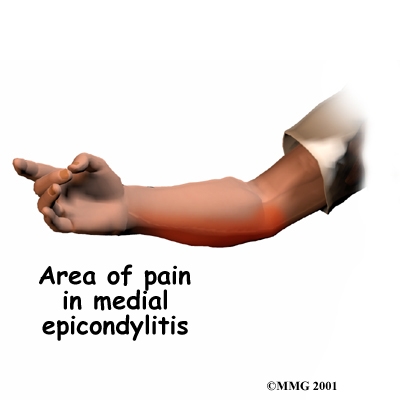A Patient's Guide to Medial Epicondylitis (Golfer's Elbow)

Introduction
Medial epicondylitis is commonly known as golfer's elbow. This does not mean that only golfers have this condition. But the golf swing is a common cause of medial epicondylitis. Many other repetitive activities can also lead to golfer's elbow--throwing, chopping wood with an ax, running a chain saw, and using many types of hand tools. Any activities that stress the same forearm muscles can cause symptoms of golfer's elbow.
This guide will help you understand
- what parts of the elbow are affected
- what causes golfer's elbow
- how to make the pain go away
Chiropractic Treatment
Chiropractic treatment is usually only needed for four to six weeks. Chiropractic manipulation can help restore the normal alignment and motion of the elbow joint. This is sometimes called closed reduction manipulation. This is where chiropractic manipulation has an advantage over other specialties. It is important to manipulate and stretch capsular joint restrictions during the treatment phase. Chiropractic care focuses on not just relieving the symptoms, but correcting the underlying problem. Before any treatment can begin, you will begin a standard chiropractic examination of the head, neck and upper back and entire upper extremity to check for any nervous system interference to the group of nerves called the brachial plexus. Research studies have shown that spinal manipulation/adjustments to the neck are effective in treating golfer's elbow.
When symptoms are from tendonosis, you can expect healing to take longer, usually up to three months. If your tendonosis is severe, it may take at least six months for complete healing. If the problem is caused by acute inflammation, sometimes anti-inflammatory medications such as ibuprofen may give you some relief, but it will not correct the problem.
Dr. Zohn and Dr. Kane will give you tips on how to rest your elbow and how to do your activities without putting extra strain on your elbow. We may apply tape to take some of the load off the elbow muscles and tendons. You may need to wear an elbow strap that wraps around the upper forearm in a way that relieves the pressure on the tendon attachment.
Ice and electrical stimulation are used to ease pain and improve healing of the tendon. Deep muscle work is sometimes performed to help breakdown scar tissue and adhesions which form in the muscles and tendons. Treatment sessions may also include iontophoresis, which uses a mild electrical current to "push" anti-inflammatory medicine to the sore area. Exercises are used to gradually stretch and strengthen the forearm muscles. Because tendonosis is often linked to overuse, your chiropractor will work with you to reduce repeated strains on your elbow. When symptoms come from a particular sport or work activity, we will observe your style and motion with the activity. You may be given tips about how to perform the movement so the elbow is protected. We can check your sports equipment and work tools and suggest how to alter them to keep your elbow safe.
Anatomy
What parts of the elbow are affected?
Golfer's elbow causes pain that starts on the inside bump of the elbow, the medial epicondyle. Wrist flexors are the muscles of the forearm that pull the hand forward. The wrist flexors are on the palm side of the forearm. Most of the wrist flexors attach to one main tendon on the medial epicondyle. This tendon is called the common flexor tendon.
Tendons connect muscle to bone. Tendons are made up of strands of a material called collagen. The collagen strands are lined up in bundles next to each other.
Because the collagen strands in tendons are lined up, tendons have high tensile strength. This means they can withstand high forces that pull against both ends of the tendon. When muscles work, they pull on one end of the tendon. The other end of the tendon pulls on the bone, causing the bone to move.
The wrist flexor muscles contract when you flex your wrist, twist your forearm down, or grip with your hand. The contracting muscles pull on the flexor tendon. The forces that pull on the tendon can build when you grip a golf club during a golf swing or do other similar actions.
Causes
Why did I develop golfer's elbow?
Overuse of the muscles and tendons of the forearm and elbow are the most common reason people develop golfer's elbow. Repeating some types of activities over and over again can put too much strain on the elbow tendons. These activities are not necessarily high-level sports competition. Shoveling, gardening, and hammering nails can all cause the pain of golfer's elbow. Swimmers who try to pick up speed by powering their arm through the water can also strain the flexor tendon at the elbow.
In some cases, the symptoms of golfer's elbow are due to inflammation. In an acute injury, the body undergoes an inflammatory response. Special inflammatory cells make their way to the injured tissues to help them heal. Conditions that involve inflammation are indicated by "-itis" on the end of the word. For example, inflammation in a tendon is called tendonitis. Inflammation around the medial epicondyle is called medial epicondylitis.
However, golfer's elbow often is not caused by inflammation. Rather, it is a problem within the cells of the tendon. Doctors call this condition tendonosis. In tendonosis, wear and tear is thought to lead to tissue degeneration. A degenerated tendon usually has an abnormal arrangement of collagen fibers.
Instead of inflammatory cells, the body produces a type of cells called fibroblasts. When this happens, the collagen loses its strength. It becomes fragile and can break or be easily injured. Each time the collagen breaks down, the body responds by forming scar tissue in the tendon. Eventually, the tendon becomes thickened from extra scar tissue.
No one really knows exactly what causes tendonosis. Some doctors think that the forearm tendon develops small tears with too much activity. The tears try to heal, but constant strain and overuse keep re-injuring the tendon. After a while, the tendons stop trying to heal. The scar tissue never has a chance to fully heal, leaving the injured areas weakened and painful.
Symptoms
What does golfer's elbow feel like?
The main symptom of golfer's elbow is tenderness and pain at the medial epicondyle of the elbow. Pain usually starts at the medial epicondyle and may spread down the forearm. Bending your wrist, twisting your forearm down, or grasping objects can make the pain worse. You may feel less strength when grasping items or squeezing your hand into a fist.

Diagnosis
How can my doctor be sure I have golfer's elbow?
Your doctor will first take a detailed medical history. You will need to answer questions about your pain, how your pain affects you, your regular activities, and past injuries to your elbow.
The physical exam is often most helpful in diagnosing golfer's elbow. Your doctor may position your wrist and arm so you feel a stretch on the forearm muscles and tendons. This is usually painful with golfer's elbow. Other tests for wrist and forearm strength are used to help your doctor diagnose golfer's elbow.
You may need to get X-rays of your elbow. The X-rays mostly help your doctor rule out other problems with the elbow joint. The X-ray may show if there are calcium deposits on the medial epicondyle at the connection to the flexor tendon.
Golfer's elbow symptoms are very similar to a condition called cubital tunnel syndrome. This condition is caused by a pinched ulnar nerve as it crosses the elbow on its way to the hand. If your pain does not respond to treatments for golfer's elbow, your doctor may suggest tests to rule out problems with the ulnar nerve.
When the diagnosis is not clear, the doctor may order other special tests, such as MRI scans or ultrasound. An MRI scan uses magnetic waves to create pictures of the elbow in slices. The MRI scan shows tendons as well as bones.
Ultrasound tests use high-frequency sound waves to generate an image of the tissues below the skin. As the small ultrasound device is rubbed over the sore area, an image appears on a screen. This type of test can sometimes show collagen degeneration.
All content provided by eORTHOPOD® is a registered trademark of Medical Multimedia Group, L.L.C.. Content is the sole property of Medical Multimedia Group, L.L.C.. and used herein by permission.
All materials from eORTHOPOD® are the sole property of Medical Multimedia Group, L.L.C.. and are used herein by permission. eORTHOPOD® is a registered trademark of Medical Multimedia Group, L.L.C..
|